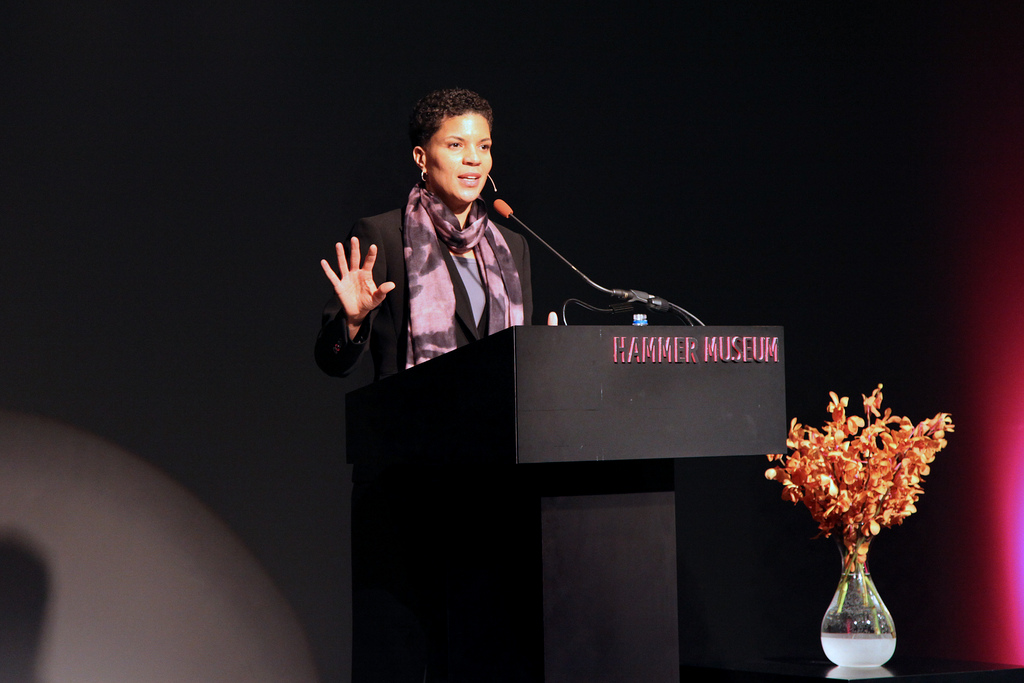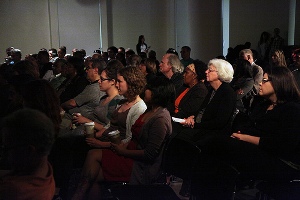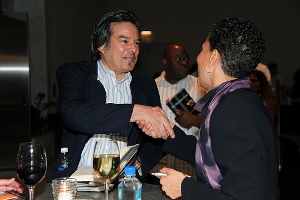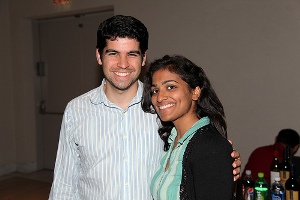
Michelle Alexander spent years as a civil rights lawyer, believing that the criminal justice system, like other American institutions, was “infected with a conscious and unconscious bias” against people of color. It wasn’t until her years working on racial profiling, drug enforcement and police brutality that she realized it was “a different beast entirely.”
“I came to see that the mass incarceration of poor people of color has emerged as a stunningly comprehensive and well-disguised system of racial control, analogous to Jim Crow,” Alexander said to the crowd at the Hammer Museum.
Believing that the election of Barack Obama signals a triumph over race is “not just deeply misguided but pure fiction,” she said. Alexander, author of The New Jim Crow: Mass Incarceration in the Age of Colorblindness, explained how our treatment of criminals has created a new racial caste system – one that can be undone only by massive social change on the level of the Civil Rights movement.
Incarceration today
Because it is no longer socially or legally permissible to use race to discriminate, Alexander argued, we discriminate based on felony status. Convicted felons can be excluded from employment, public housing, jury duty, voting, and other public benefits. “They have scarcely more rights and arguably less respect than a black man living in Alabama at the height of Jim Crow,” Alexander said.
And a disproportionate number of those labeled felons are African Americans, and the label sticks. More African Americans are either in prison or jail or on probation or parole than were enslaved in 1850. As of 2004, more black men were disenfranchised due to their felon status than in 1870. In some urban areas today, Alexander noted, a large majority of African American men are felons.
They help make up an enormous prison population, which has increased from 300,000 to two million in 30 years, an incarceration rate that dwarfs those of China and Iran. No other country imprisons such a large portion of its racial and ethnic minorities, Alexander said. The rise has little to do with crime rates, which are at their lowest today. “The emergence of this new system has been sudden and quite dramatic,” she said. “No one would have predicted this just a few decades ago.” Indeed, in the 1970s, Alexander noted in Q&A, many criminologists thought the prison system would fade away.
On the drug war
 The primary reason for the explosion in the prison population, Alexander argued, is the War on Drugs. Drug offenses have led to two-thirds of the increase in the federal and more than half of the increase in the state incarceration rate. The enforcement of drug laws has occurred almost exclusively in poor communities of color, though they are no more likely to use or sell illegal drugs than whites, Alexander said. Markets are segregated – “rural whites don’t drive to the hood to get their marijuana” – but enforcement focuses on particular communities. In some states, 80 to 90 percent of drug offenders admitted to prison are African American. Four in five of them are charged only with possession; most drug offenders in state prison have no history of violence or significant selling activity.
The primary reason for the explosion in the prison population, Alexander argued, is the War on Drugs. Drug offenses have led to two-thirds of the increase in the federal and more than half of the increase in the state incarceration rate. The enforcement of drug laws has occurred almost exclusively in poor communities of color, though they are no more likely to use or sell illegal drugs than whites, Alexander said. Markets are segregated – “rural whites don’t drive to the hood to get their marijuana” – but enforcement focuses on particular communities. In some states, 80 to 90 percent of drug offenders admitted to prison are African American. Four in five of them are charged only with possession; most drug offenders in state prison have no history of violence or significant selling activity.
The enforcement also does not necessarily target drug kingpins or violent offenders, Alexander said. Federal funding flows to agencies that boost the volume of their drug arrests, not those that bring down bosses. Agencies can also keep up to 80 percent of cash and goods they seize, giving them a monetary incentive in the drug market, she said.
Southern votes
In fact, the drug war’s motives were never as benign as they may seem, Alexander said. Drug crime had been on the decline when Reagan launched the effort in 1982. He was motivated, Alexander argued, by racial politics. The Republican party sought Southern votes, particularly from poor and working class whites. With fair reason, Alexander noted, they were upset by the social shifts after the 1960s, having to compete for jobs “with people they had been taught to believe were inferior.” The Reagan administration publicized crack to build support for the drug war, which, Alexander said, “forever changed our conceptions of who drug users and dealers are and what should be done.”
A change in parties didn’t help. “Clinton’s crime policy amounted to the greatest increase in African American incarceration rates of any American president in history,” Alexander said. The 1990s saw a major rise in drug arrests, 80 percent of which were for marijuana possession. Clinton also banned drug offenders from accessing public housing and food stamps.
Criminal stigma
 The result of mass incarceration, and the denial of benefits to felons, leaves one in seven African American men disenfranchised nationwide, Alexander said. Job applications for many positions require convicted felons to declare that status. Professional licenses – sometimes even for becoming a barber – are withheld. Food stamps are denied as well, even to pregnant women. Jury service isn’t allowed, making for a comeback for the all-white jury in some parts of the country. Felons can’t get public housing for a minimum of five years, and private landlords are free to discriminate. And the caste system, she said, is “hungry.” Latinos are increasingly becoming a part of it, particularly as private detention centers sprout to house immigrant offenders.
The result of mass incarceration, and the denial of benefits to felons, leaves one in seven African American men disenfranchised nationwide, Alexander said. Job applications for many positions require convicted felons to declare that status. Professional licenses – sometimes even for becoming a barber – are withheld. Food stamps are denied as well, even to pregnant women. Jury service isn’t allowed, making for a comeback for the all-white jury in some parts of the country. Felons can’t get public housing for a minimum of five years, and private landlords are free to discriminate. And the caste system, she said, is “hungry.” Latinos are increasingly becoming a part of it, particularly as private detention centers sprout to house immigrant offenders.
Finally, felons are expected to pay thousands in fees and fines – 100 percent of their wages can be used to pay the cost of their imprisonment. It’s a system not too unlike that the post-Civil War era, when black men convicted for loitering or vagrancy were sent to work on plantations and charged with earning their freedom, without ever making enough to do it. “What is this system designed to do? Put you right back in prison,” Alexander said. Seventy percent of offenders are sent back to prison within three years; a majority of those return within a few months.
Beyond the formal barriers, Alexander said, the stigma is difficult to bear. “The look that flashes across an employer’s face once that box has been checked,” she said. “Or a grown man begging his grandma for a place to sleep at night because nowhere else will take him in.” Even in neighborhoods with high felon populations, not one was found to have admitted his status to all their friends or loved ones.
A human rights movement
 The silence, Alexander said, leaves us in denial about the way racist oppression works – through indifference rather than conscious bigotry. That’s true even of slavery and the old Jim Crow, she said. “Many people who supported Jim Crow actually consciously wished well for their black maids or black shoe-shiners,” Alexander said. “They’re blind to the suffering of people of other races.” We also have a false picture of racial reality since felons are erased from many key social and economic statistics. “When you read that the black unemployment rate is x, go ahead and add 15 to 20 percentage points to that,” Alexander said. The black poverty rate is roughly the same as it was in 1968, and the child black poverty rate is higher.
The silence, Alexander said, leaves us in denial about the way racist oppression works – through indifference rather than conscious bigotry. That’s true even of slavery and the old Jim Crow, she said. “Many people who supported Jim Crow actually consciously wished well for their black maids or black shoe-shiners,” Alexander said. “They’re blind to the suffering of people of other races.” We also have a false picture of racial reality since felons are erased from many key social and economic statistics. “When you read that the black unemployment rate is x, go ahead and add 15 to 20 percentage points to that,” Alexander said. The black poverty rate is roughly the same as it was in 1968, and the child black poverty rate is higher.
To change the system, Alexander said, the civil rights community needs to acknowledge its fault. “We’ve allowed a human rights nightmare to occur on our watch,” she said. A broad social movement is the only way to end it, Alexander argued. Piecemeal changes to the law aren’t enough, and the Supreme Court has mostly ignored cases asserting racial discrimination in the criminal justice system, demanding proof of conscious, intentional bias. The movement must include people of many races and ethnicities, particularly poor whites, and it must evoke the language of human rights, which can’t be forfeited based on behavior. The movement must be “one that rivals the Civil Rights movement in size, scale, depth and courage,” she said. “We’ve got to awake from this color-blind slumber to the realities of race in America.”
Watch the video here.
See more photos here.
Buy the book here.
Read Alexander’s In The Green Room Q&A here.
*Photos by Aaron Salcido.




Send A Letter To the Editors